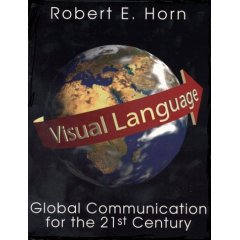Visual languageGlobal communication for the 21st century
|

|
 Diese Seite wurde seit 2 Jahren inhaltlich nicht mehr aktualisiert.
Unter Umständen ist sie nicht mehr aktuell.
Diese Seite wurde seit 2 Jahren inhaltlich nicht mehr aktualisiert.
Unter Umständen ist sie nicht mehr aktuell.
 Zusammenfassungen
Zusammenfassungen
 Visual Language explains an emerging international language that co-mingles words and images to convey holistic and complex ideas.
Visual Language explains an emerging international language that co-mingles words and images to convey holistic and complex ideas. In this book, Bob Horn has brought together the depth of his years of experience in information design with a wealth of research on the history and practice of visual languages. The result is a new synthesis: a way of thinking about visual language that integrates and extends the different elements on which he draws. It may come to be, as he predicts, the starting point for a new field of study that develops the "global language for the 21st century."
In this book, Bob Horn has brought together the depth of his years of experience in information design with a wealth of research on the history and practice of visual languages. The result is a new synthesis: a way of thinking about visual language that integrates and extends the different elements on which he draws. It may come to be, as he predicts, the starting point for a new field of study that develops the "global language for the 21st century." Bemerkungen zu diesem Buch
Bemerkungen zu diesem Buch
 The idea for this book initially arose on the day, in 1984, that I first saw a Macintosh computer. I realized that easy access to computerized drawing programs would bring into being a whole new world of communication possibilities. For the first time, nonartists could use the computer to draw and could endlessly modify and reuse drawings once they were created. I immediately began to use some clip art in ordinary business and personal communications. At that time, I was CEO of Information Mapping, Inc., now one of the world's premier information management companies, and I thought of the graphic computer as simply a way to add graphics to our existing method of analyzing and organizing business communication documents.
The idea for this book initially arose on the day, in 1984, that I first saw a Macintosh computer. I realized that easy access to computerized drawing programs would bring into being a whole new world of communication possibilities. For the first time, nonartists could use the computer to draw and could endlessly modify and reuse drawings once they were created. I immediately began to use some clip art in ordinary business and personal communications. At that time, I was CEO of Information Mapping, Inc., now one of the world's premier information management companies, and I thought of the graphic computer as simply a way to add graphics to our existing method of analyzing and organizing business communication documents. Dieses Buch erwähnt ...
Dieses Buch erwähnt ...
 Dieses Buch erwähnt vermutlich nicht ...
Dieses Buch erwähnt vermutlich nicht ... 
 Nicht erwähnte Begriffe | Semantik, Virtualität |
 Tagcloud
Tagcloud
 Zitationsgraph
Zitationsgraph
 Zitationsgraph (Beta-Test mit vis.js)
Zitationsgraph (Beta-Test mit vis.js)
 Zeitleiste
Zeitleiste
 12 Erwähnungen
12 Erwähnungen 
- The Language of Graphics - A framework for the analysis of syntax and meaning in maps, charts and diagrams (Jörg von Engelhardt) (2002)


- Visualizing Argumentation (Paul A. Kirschner, Simon J. Buckingham Shum, Chad Carr) (2003)
- 1. The Roots of Computer Supported Argument Visualization (Simon J. Buckingham Shum)
- 8. Infrastructure for Navigating Interdisciplinary Debates (Robert E. Horn)
- Knowledge Visualization (Martin Jürg Eppler, Remo A. Burkhard) (2004)


- Tube Map Visualization - Evaluation of a Novel Knowledge Visualization Application for the Transfer of Knowledge in Long-Term Projects (Remo A. Burkhard, Michael Meier) (2005)

- Semantic Web - Wege zur vernetzten Wissensgesellschaft (Tassilo Pellegrini, Andreas Blumauer) (2006)
- Knowledge Visualization - Die nächste Herausforderung für Semantic Web Forschende? (Remo A. Burkhard)

- Knowledge Visualization - Die nächste Herausforderung für Semantic Web Forschende? (Remo A. Burkhard)
- Towards A Periodic Table of Visualization Methods for Management (Ralph Lengler, Martin Jürg Eppler) (2006)


- Informal Learning - Rediscovering the Natural Pathways That Inspire Innovation and Performance (Jay Cross) (2006)


- Koli Calling 2010 - 10th Koli Calling International Conference on Computing Education Research, Koli Calling '10, Koli, Finland, October 28-31, 2010 (Carsten Schulte, Jarkko Suhonen) (2010)
- Review of recent systems for automatic assessment of programming assignments (Petri Ihantola, Tuukka Ahoniemi, Ville Karavirta, Otto Seppälä) (2010)


- Review of recent systems for automatic assessment of programming assignments (Petri Ihantola, Tuukka Ahoniemi, Ville Karavirta, Otto Seppälä) (2010)
- The Data Revolution (Rob Kitchin) (2014)

- Informatics in Schools: Fundamentals of Computer Science and Software Engineering (Sergei Pozdniakov, Valentina Dagienė) (2018)


- Computational Thinking in Education - A Pedagogical Perspective (Aman Yadav, Ulf Dalvad Berthelsen) (2021)

- 6. Assessment of Computational Thinking (David Weintrop, Daisy Rutstein, Marie A. Bienkowski, Steven McGee)
 Co-zitierte Bücher
Co-zitierte Bücher

Readings in Information Visualization
Using Vision to Think
(S. Card, J. Mackinlay, Ben Shneiderman) (1999)
Mapping hypertext
analysis, organization, and display of knowledge for the next generation of on-line text and graphics
(Robert E. Horn) (1989)
The Principles of Gestalt Psychology
(Kurt Koffka) (1935) Bibliographisches
Bibliographisches 
 Beat und dieses Buch
Beat und dieses Buch
Beat war Co-Leiter des ICT-Kompetenzzentrums TOP während er dieses Buch ins Biblionetz aufgenommen hat. Die bisher letzte Bearbeitung erfolgte während seiner Zeit am Institut für Medien und Schule. Beat besitzt weder ein physisches noch ein digitales Exemplar.









 Classification
Classification Computer
Computer Design
Design distance learning / Fernunterricht
distance learning / Fernunterricht information design
information design Internet
Internet Management
Management Multimedia
Multimedia Virtual Reality
Virtual Reality










 Biblionetz-History
Biblionetz-History